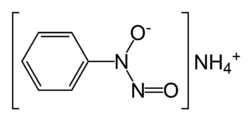Chemistry:Phenylhydroxylamine
| |||
| Names | |||
|---|---|---|---|
| Preferred IUPAC name
N-Hydroxyaniline | |||
| Other names
beta-phenylhydroxylamine; phenylhydroxylamine; N-hydroxybenzeneamine; hydroxylaminobenzene
| |||
| Identifiers | |||
3D model (JSmol)
|
|||
| ChEBI | |||
| ChemSpider | |||
| EC Number |
| ||
| KEGG | |||
PubChem CID
|
|||
| UNII | |||
| |||
| |||
| Properties | |||
| C6H7NO | |||
| Molar mass | 109.1274 g/mol | ||
| Appearance | yellow needles | ||
| Melting point | 80 to 81 °C (176 to 178 °F; 353 to 354 K) | ||
| -68.2·10−6 cm3/mol | |||
| Related compounds | |||
Related compounds
|
hydroxylamine, nitrosobenzene | ||
Except where otherwise noted, data are given for materials in their standard state (at 25 °C [77 °F], 100 kPa). | |||
| Infobox references | |||
Phenylhydroxylamine is the organic compound with the formula C6H5NHOH. It is an intermediate in the redox-related pair C6H5NH2 and C6H5NO. Phenylhydroxylamine should not be confused with its isomer α-phenylhydroxylamine or O-phenylhydroxylamine.
Preparation
This compound can be prepared by the reduction of nitrobenzene with zinc in the presence of NH4Cl.[1][2]
Alternatively, it can be prepared by transfer hydrogenation of nitrobenzene using hydrazine as an H2 source over a rhodium catalyst.[3]
Reactions

Phenylhydroxylamine is unstable to heating, and in the presence of strong acids easily rearranges to 4-aminophenol via the Bamberger rearrangement. Oxidation of phenylhydroxylamine with dichromate gives nitrosobenzene.
Like other hydroxylamines it will reaction with aldehydes to form nitrones, illustrative is the condensation with benzaldehyde to form diphenylnitrone, a well-known 1,3-dipolar compound:[4]
- C6H5NHOH + C6H5CHO → C6H5N(O)=CHC6H5 + H2O
Phenylhydroxylamine is attacked by NO+ sources to give cupferron:[5]
- C6H5NHOH + C4H9ONO + NH3 → NH4[C6H5N(O)NO] + C4H9OH
References
- ↑ E. Bamberger “Ueber das Phenylhydroxylamin” Chemische Berichte, volume 27 1548-1557 (1894). E. Bamberger, "Ueber die Reduction der Nitroverbindungen" Chemische Berichte, volume 27 1347-1350 (1894) (first report)
- ↑ O. Kamm (1941). "Phenylhydroxylamine". Organic Syntheses 4: 57. doi:10.15227/orgsyn.004.0057.
- ↑ P. W. Oxley, B. M. Adger, M. J. Sasse, M. A. Forth (1989). "N-Acetyl-N-Phenylhydroxylamine via Catalytic Transfer Hydrogenation of Nitrobenzene using Hydrazine and Rhodium on Carbon". Organic Syntheses 67: 187. doi:10.15227/orgsyn.067.0187.
- ↑ I. Brüning, R. Grashey, H. Hauck, R. Huisgen, H. Seidl (1966). "2,3,5-Triphenylisoxazolidine". Organic Syntheses 46: 127. doi:10.15227/orgsyn.046.0127.
- ↑ C. S. Marvel (1925). "Cupferron". Organic Syntheses 4: 19. doi:10.15227/orgsyn.004.0019.
 |



